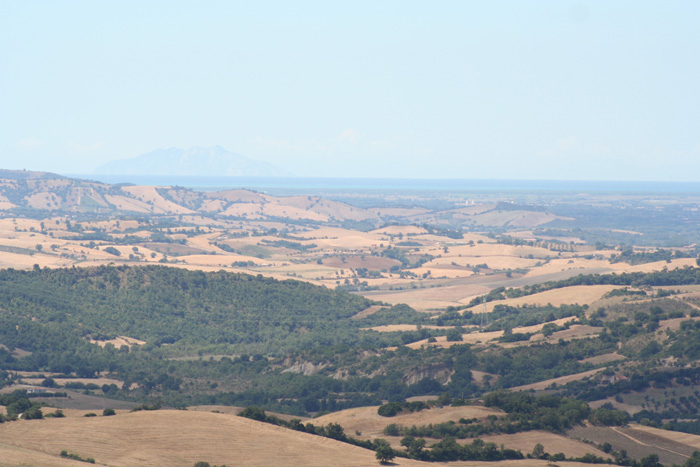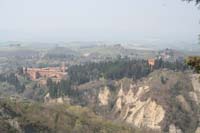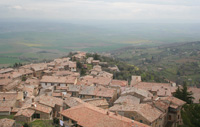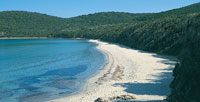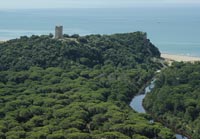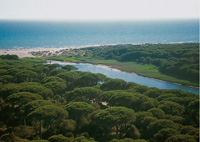|
| Few other parts of Italy have preserved its land like that of the Province of Grosseto. It is not, therefore, by chance that the nearly untouched environment of the Maremma, with its rolling hills, represents a true treasure for those who love and respect nature.
For nature lovers, the Maremma offers infinite opportunity to explore fascinating locations rich in history. The Maremma, the area of Tuscany which was once the heartland of the Etruscans stretches along the Southern Tuscan coast and inland to the hills of the Alta Maremma and the Tufo Area.After the Etruscan era, the coastal areas deteriorated into marshland and swamp, infested with malarial mosquito and inhabited only by charcoal burners, shepherds and cowboys, the "butteri". It was not until 1950 that the malarial mosquito was eliminated. As a result, this is one of the last unspoilt stretches of coastline in Italy. Traveling south from Grosseto you reach the Maremma Regional Park (Parco Regionale della Maremma), also known as Uccellina Park (Parco dell’Uccellina), the most exclusive and beautiful natural conservation area in Tuscany. The parc covers a coastal area between Principina a Mare and Talamone near Grosseto, Magliano in Toscana and Orbetello, right up to the Livorno-Roma train line. The park covers 9000 hectares plus an extra 8500 hectares of open land around its boundaries. The parks goes from the mouth of the river Ombrone up to Talamone. This 25km stretch has hills that gently descend across marshland, farmland and grazing pastures down to the sandy and rocky beaches along the coast. The air is full of the perfume of aromatic shrubs and the sound of animal cries. Bright berries provide splashes of colour. The park presents visitors with a mix of soft sounds, smells and sights that delight the senses, and harsh, raw wildlife. This clash of natural sensations gives visitors the impression of being truly at one with nature and makes this the perfect place to get away from otherwise hectic lives, relax and de-stress. The landscape is rich and diverse. The ridge of the Uccellina hills runs through the park, its highest peak being Poggio Lecci at 417m. Lower down, the river Ombrone provides a natural dividing line between the partially reclaimed flood plains, the Trappola marshlands and the coast with its sandy beaches and steep rocky cliffs. The Trappola marshes are in fact one of the largest strips of salt water marshland in Tuscany. The scenery of the mountainous Monte Argentario, which reaches 635 metres at its highest point, Il Telegrapho, is dramatic, with headlands, bays and shingle beaches. Much of the area is still uninhabited and superb walking country. The main tourist centres are the ancient ports of San Stefano and Ercole. Three 16th century castles, remnants of the Spanish fortification of the Argentario, look down upon the yacht-filled harbor of the attractive little town of Porto Ercole. |
 |
Podere Santa Pia, garden view over the Maremma hills (August) |
History The ancient Roman road known as the Via Aurelia stretches along the eastern border of the Maremma and hints at the region’s illustrious past. Saturnia, a village south of Grosseto near Tuscany’s border with Lazio, is home to a collection of sulfurous thermal springs that the Romans and, later, the Medici revered for their curative properties. A luxurious spa complex has been built around these healing waters, but those who enjoy the great outdoors can take advantage of the natural pools along the side of the road free of charge. Earlier than even the Romans were the Etruscans, who first settled the fertile soils of the Maremma region. The ancient citadel of Tarquinia is just south of the Lazio confines, the settlement of Volterra is to the north; the captivating archaeological excavations of both villages can easily be visited as a daytrip from any holiday rental in the Maremma. The Strada della Regina was once the road that connected the seacoast to the Via Aurelia. Along this road is the Abbey of San Rabano, dating back to the 12th century. Torre del Castelmarino and Collelungo, the famous medieval towers that surround Benedictine settlement, were originally constructed to observe the seacoast and spot the arrival of rival Saracen ships and alert the townspeople to impending danger. The warring cities of Pisa and Siena fought over San Rabano during the 14th century, and it was completely refurbished by the powerful Medici family in the 16th century in an effort to restore the ancient Tuscan coastal ports. These towers are just a few of the landmarks found in the epic Maremma nature preserve. |
||||
Monte Oliveto Maggiore abbey |
Abbey of Sant 'Antimo |
Montalcino |
||
Cala Violina |
Castiglione della Pescaia The most famous part of the Maremma is the Parco Naturale della Maremma, otherwise known as the Parco dell'Uccellina
|
Principina a Mare The Ombrone River located along the coast of Maremma Grossetana, where it flows into the Tyrrhenian Sea in Principina a Mare. |
||
 |
||||
| Sunflowers in bloom, Maremma Toscana, Castiglione della Pescais. Foto da Giovanni from Firenze, Italy, sotto la licenza Creative Commons Attribuzione 2.0 Generico | ||||
